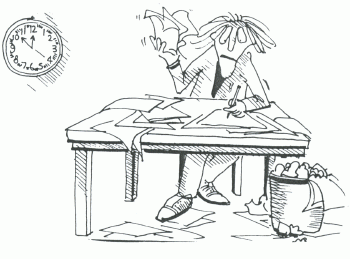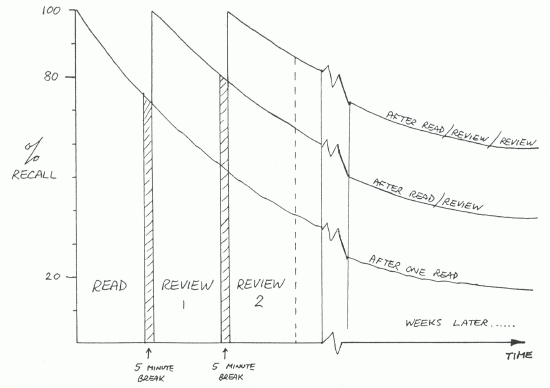|
OUT OF YOUR LEARNING ABILITY "You cannot teach a man or woman anything;
you can only help them to find it within themselves."
"Just as eating against one's will is injurious
to the health, so study without a liking for it spoils the memory, and
it retains nothing it takes in."
The only way to make study work for you is to avoid BOREDOM - the worst enemy of learning. From a very early age, we vary what we do to stop ourselves getting bored. We look for new tasks and seek new ways to do things. Sometimes even this fails and we fall into the boredom-trap. We cannot be bothered to find ways to cure our boredom because we are too bored. Over time we develop a concentration-span - the time between starting a task to the time we find our minds wandering. This is because your brain deals with information in a very special way. The brain receives information from our senses. This is then passed on to our short-term memory where it is stored for a short time. From then on the information in short-term memory must be passed on to long-term memory or we end up "forgetting" the information. Your brain's ability to do this depends on how you feel. If you are bored, short term memory is lost very quickly and so can never be passed on. You may be surprised to learn that it is not lost forever - it is stored away often never to be remembered again. The best way to learn is to limit study periods to the length of our concentration-span. This gives the brain the best chance to store what we are studying in long-term memory.
Now that you know what your own brain can cope with you can sort out your reading and revision to suit.
study beyond your concentration-span. You may still be reading but your
brain will be losing most of the information it takes in. This makes it
pointless to go on. You may satisfy your need to feel as if you are working
hard, but the amount you actually remember will get less and less.
After studying for the time you found was best, you must then take a rest for about five minutes. Do something else not connected with your work. Listen to music, have a snack, refresh yourself - but don't stop thinking about what you were reading. This may be an unusual thing to do in the middle of a study session, but your brain needs that time to sort out the information in your short-term memory. At the end of the rest period, the information you were reading will be much clearer than it was to begin with. Short-term memory lasts between 12 to 48 hours. If you stopped at this point you would be able to recall only about 10-20% of the information you read. To get the information into long-term
memory you must REVIEW.
STUDY TOPIC After your five-minute rest, read the same information again. Concentrate only on those points that are most important. Then take another five-minute break and re-read once more, fitting all the bits of information together. Both of these reviews would be made even better by note-taking in whatever way you find easy and helpful. Make sure that the notes you make are well organised! ONE WEEKand TWO WEEKS later review the topic again using your notes. By now you should have found that there has been a huge improvement in your ability to remember, understand and use that information. Finally, you must REVISE. This is simply a way of drawing loose ends together with the same study method but this time using your notes only. If you use the above methods while you are still following a course of study, your final revision will be made much easier. Some students who have used these methods early find that very little final revision is necessary. They became so good at remembering the work during the course of the year that they didn't need to do any more! The Read / Review / Review Graph
Study is like building a jigsaw : Lay out the pieces Sort out the edges Build inwards towards the most difficult parts Put in the final pieces Stand back and appreciate! In learning, the pieces of knowledge you have can be swapped between several jigsaws in your mind - but there is no pattern which you can follow. By making patterns yourself all the pieces fall into place. Soon, that wonderful feeling of excitement hits you when you look down and see how the jigsaw fits together. If you make patterns within your work then several pieces can be missing from the middle, but by looking at their neighbours a guess can be made as to what the missing pieces should be. In other words - you do not have to know everything! By improving your reading and note-taking
skills you can speed up the building of the jigsaw and increase your ability
to remember the pattern.
(THE "Q-S-R" TECHNIQUE) Q: QUICKLY read the page or chapter you wish to study. S: SCAN each page at a time noting key words or sections as you read through fairly quickly. R: READ the page or chapter carefully and thoughtfully, making more notes as you go if you like. Concentrate on the key words or sections you highlighted, using them as trigger points for recall.
The purpose of notes is not to copy out great chunks of information from books. They should only act as a trigger to help you remember what you have read. Key words are more easily remembered than long sentences! Notes should be short, to the point,
well-organised and easily read. The exact style is up to you and you only.
Some tried and tested methods are given in the next section.
SERIAL NOTES This is a simple note-making style and is best for making notes during lessons. Don't write everything you hear or read but select out the most important points. Concentrate only on those pointers that will help you recall the lesson content. Improve upon them later when time allows. Use lots of headings, sub-headings, numbered points, "bullets", etc. For example: Or:
and so onů MIND-MAPS® (based on the work of Tony Buzan) Useful for making short notes for revision. Stretch points outwards from a main point or key word. These are best drawn from notes made during lessons which have then been added to with further information from text books. Software is also available to make drawing and revising a Mind Map easy - go to www.mindmapper.com
KEY-WORD INDEXING This requires the use of index cards which can be purchased at any stationers. As you revise notes write down key-words in two categories: HEADERS and LINKED WORDS. Use the HEADERS as titles for the index cards, and beneath this write a list of the LINKED WORDS. When revising a topic have the index cards in front of you. With practice, just the thought of a HEADER word will trigger recall of most, if not all, of the rest. For example:
BRAINSTORMING Brainstorming is best used when revising in groups (but can be used by someone working alone) and combines all of the above techniques. This is especially good for working out what to put in an essay or extended assignment. Think of everything you can to do with a topic, no matter how odd or unusual. Note down the words and/or ideas, discuss how important they are. From that discussion develop a pattern that makes sense of the things mentioned by getting rid of those that stray from the point.
|





